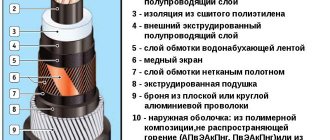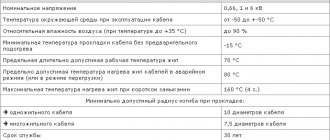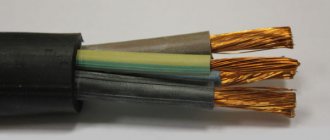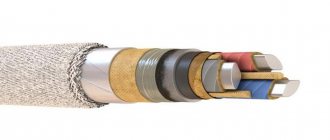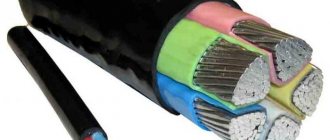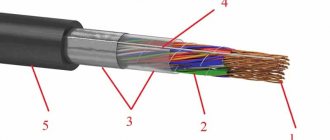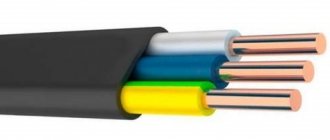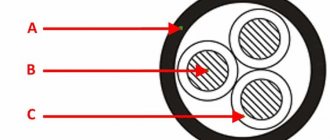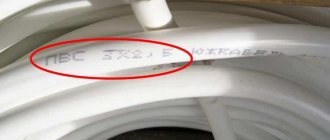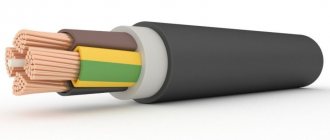The correct choice of electrical cable to power electrical equipment is the key to long-term and stable operation of installations. Using the wrong wire has serious negative consequences.
The physics of the process of damage to an electrical line due to the use of an unsuitable wire is as follows: due to the lack of space in the cable core for the free movement of electrons, the current density increases; this leads to excess energy release and an increase in the temperature of the metal. When the temperature gets too high, the line's insulating sheath melts, which can cause a fire.
To avoid trouble, you must use a cable with cores of suitable thickness. One way to determine the cross-sectional area of a cable is to start from the diameter of its cores.
Calculation of cable cross-section by diameter. Option #1
Fig.1
It is possible to determine the cable cross-section by the diameter of the core. In practice, the diameter of the core without insulation is most often measured with a caliper or micrometer. To remember how to work with a caliper when measuring the diameter of a core, see Fig. 1
Knowing the core diameter, it is quite easy to determine the cable cross-section. To do this, you need to use the cable cross-section formula, which coincides with the usual school formula for calculating the area of a circle (Fig. 2)
Rice. 2 Formula for calculating cable cross-section
Example of section calculation:
A 3-core VVGng cable without markings with a core diameter of 5.6 mm was received at the warehouse. Let's determine the cross-section of the VVGNg cable by diameter: Skr=3.14*5.6^2/4=24.6 mm2
The nearest standard section is 25mm2. Thus, the VVGng 3x25 cable was delivered to the warehouse.
What to do if the actual cross-section does not match that indicated on the marking? Cable manufacturers also have their own tolerances regarding the cross-section of cable cores. These tolerances are regulated by GOST 22483-77, according to which the cross-section of the core must correspond to the electrical resistance specified in GOST.
For example, for a VVG cable (core flexibility class 1), the range of core diameters corresponding to GOST is calculated and shown in the table below:
| Nominal cross-section, mm2 | Max. core diameter, mm | Min. core diameter based on max resistance according to GOST 22483-77, mm |
| 0,5 | 0,80 | 0,78 |
| 0,75 | 0,98 | 0,95 |
| 1 | 1,13 | 1,10 |
| 1,5 | 1,38 | 1,35 |
| 2,5 | 1,78 | 1,72 |
| 3 | 1,95 | 1,90 |
| 4 | 2,26 | 2,18 |
| 5 | 2,52 | 2,45 |
| 6 | 2,76 | 2,67 |
| 8 | 3,19 | 3,12 |
| 10 | 3,57 | 3,46 |
| 25 | 5,64 | 5,49 |
| 35 | 6,68 | 6,47 |
| 50 | 7,98 | 7,52 |
| 70 | 9,44 | 9,04 |
| 95 | 11,00 | 10,65 |
| 120 | 12,36 | 11,97 |
| 150 | 13,82 | 13,29 |
| 185 | 15,35 | 14,87 |
| 240 | 17,49 | 17,05 |
Read more about this in our article - Undersized cable cross-section. Acceptable norms for underestimation of cross-section
Features of laying VVG cable in trays
PUE 2.1.61.
In boxes (cable tray + cover), wires and cables can be laid in multi-layers with an ordered and random (scattered) mutual arrangement. The sum of the cross-sections of wires and cables, calculated by their outer diameters, including insulation and outer sheaths, should not exceed: for blind boxes (non-perforated tray + cover) 35% of the clear cross-section of the box; for boxes with openable lids 40%. It is advisable to use these conditions as a guide when calculating and selecting the size of cable pipes, metal trays, plastic boxes or to calculate the cost of delivery of cable products.
Table of ratios of diameters and sections
Determining the cross-sections of cables and wires using formulas is considered a rather labor-intensive and complex process that does not guarantee an accurate result. For these purposes, there is a special ready-made table, the diameter and cross-section of the wire in which clearly represents their relationship. For example, with a conductor diameter of 0.8 mm, its cross-section will be 0.5 mm. A diameter of 1 mm corresponds to a cross-section of 0.75 mm, and so on. It is enough just to measure the diameter of the wire, and then look at the table and calculate the required cross-section.
When performing calculations, you must follow certain recommendations. To determine the cross-section, it is necessary to use a wire that is completely stripped of insulation. This is due to the possible reduced dimensions of the cores and a higher insulating layer. If there is any doubt about the size of the cable, it is recommended to purchase a conductor with a higher cross-section and power reserve. In the case of determining the cross-section of a multi-core cable, the diameters of individual wires are first calculated, the resulting values are summed up and used in a formula or table.
Outer diameters of power cable (Table)
The reference table contains the outer diameters (mm) of three-core power cables with oil-impregnated paper insulation in a common aluminum or lead sheath for a voltage of 10 kV
| nxS mm2 | ASG | AAG | ASShv | AAShv AAShp | ASBG | ASB | ASBL ASB2l | AABl AAB2l | SBG | SB | SBl SB2l |
| 3×25 | 27,90 | 27,10 | 32,30 | 31,90 | 33,10 | 37,50 | 38,50 | 38,50 | 33,90 | 37,40 | 38,40 |
| 3×35 | 30,00 | 29,00 | 34,10 | 33,80 | 34,90 | 39,30 | 40,30 | 40,40 | 35,80 | 39,40 | 40,40 |
| 3×50 | 32,30 | 31,30 | 36,80 | 36,50 | 37,20 | 41,60 | 42,60 | 42,70 | 38,40 | 41,60 | 42,60 |
| 3×70* | — | 35,60 | — | 38,80 | 39,70 | 44,10 | 45,10 | 45,00 | 41,20 | 45,60 | 46,60 |
| 3×70 | 34,80 | 33,60 | 39,30 | 40,80 | — | — | — | 47,00 | — | 49,20 | — |
| 3×95 | 37,40 | 36,50 | 42,20 | 41,70 | 42,60 | 47,00 | 48,00 | 47,90 | — | — | — |
| 3×95* | — | 38,70 | — | 42,90 | — | — | — | 50,10 | 44,80 | 49,20 | 50,20 |
| 3×120 | 40,00 | 38,90 | 44,50 | 44,10 | 44,90 | 49,30 | 50,30 | 50,30 | — | — | — |
| 3×120* | — | 42,40 | — | 48,00 | — | — | — | 53,80 | 47,80 | 52,20 | — |
| 3×150 | 43,00 | 41,80 | 47,60 | 47,40 | 47,60 | 52,00 | 53,00 | 53,20 | — | — | 53,20 |
| 3×150* | 44,60 | 45,40 | 49,20 | 50,90 | 49,20 | 53,60 | 54,60 | 56,70 | 51,30 | 55,70 | 56,70 |
| 3×185 | 45,50 | 44,80 | 50,30 | 50,40 | 50,30 | 54,70 | 55,70 | 56,20 | — | — | — |
| 3×185* | 47,90 | 48,30 | 52,50 | 53,90 | 52,50 | 56,90 | 57,90 | 59,70 | 54,30 | 58,70 | 59,70 |
| 3×240 | 49,50 | 48,60 | 54,10 | 54,20 | 54,10 | 58,50 | 59,50 | 60,00 | — | — | — |
| 3×240* | 52,80 | 53,30 | 57,80 | 59,30 | 58,60 | 63,00 | 64,00 | 65,90 | 60,50 | 64,90 | 65,90 |
The table contains the outer diameters (mm) of four-core power cables with oil-impregnated paper insulation in a common aluminum or lead sheath for a voltage of 1 kV
| nxS mm2 | ASG | AAG | ASShv | AAShv | ASBG | ASB | ASBL ASB2l | AABL | SBG | SB | SBl SB2l |
| 4×25 | 19,30 | — | 23,20 | — | 24,40 | 28,80 | 29,80 | — | 26,70 | 29,50 | 30,50 |
| 4×35 | 21,50 | 22,00 | 25,80 | 27,00 | 26,60 | 31,00 | 32,00 | 33,70 | 27,20 | 31,60 | 32,60 |
| 4×50 | 24,40 | 24,90 | 28,70 | 30,00 | 29,50 | 33,90 | 34,90 | 36,40 | 37,40 | 34,40 | 35,40 |
| 4×70 | 27,20 | 28,00 | 31,60 | 33,40 | 32,40 | 36,80 | 37,80 | 39,80 | 35,60 | 40,00 | 40,00 |
| 4×70* | 29,50 | 28,80 | 33,90 | 33,90 | 34,70 | 39,10 | 40,10 | 40,30 | 41,30 | 41,40 | 41,40 |
| 4×95 | 30,60 | 30,50 | 34,70 | 36,00 | 35,50 | 39,90 | 40,90 | — | 39,10 | 43,50 | — |
| 4×95* | 33,10 | 33,50 | 37,60 | 38,90 | 38,00 | 42,40 | 43,40 | 44,90 | 44,30 | 44,40 | 44,40 |
| 4×120 | 34,20 | 36,30 | 38,70 | 41,80 | 39,10 | 43,50 | 44,50 | — | 43,60 | 47,90 | 47,90 |
| 4×120* | 37,60 | 36,80 | 42,10 | 42,20 | 42,50 | 46,90 | 47,90 | 48,20 | 47,80 | 48,00 | 49,00 |
| 4×150* | — | 37,50 | 45,30 | 45,30 | 46,00 | 51,30 | 51,30 | 51,40 | — | 50,80 | 50,80 |
| 4×185* | — | 40,10 | 49,30 | 49,60 | 49,70 | 54,90 | 54,90 | 55,20 | — | 54,30 | 54,30 |
| 4×240* | — | 48,90 | 54,50 | 54,80 | 54,90 | 60,10 | 60,10 | 60,40 | — | — | — |
The table contains the outer diameters (mm) of four-core power cables with plastic insulation for voltage 1 kV
| nxS mm2 | with PVC insulation | with XLPE insulation | ||||||
| AVVG | VVG | AVBbShv | VBBShv | APvVG | PvVG | APvBbShv | PvBbShv | |
| 4×16 | 18,90 | 20,40 | 22,50 | 24,00 | 18,30 | 20,20 | — | 23,80 |
| 4×25 | 22,70 | 23,20 | 26,70 | 27,20 | 22,50 | 22,90 | — | 26,90 |
| 4×35 | 25,50 | 26,00 | 29,30 | 29,80 | 25,70 | 26,10 | — | 29,90 |
| 4×50 | 29,60 | 29,60 | 33,40 | 33,40 | 31,60 | 30,60 | 34,70 | 34,80 |
| 4×70 | 33,00 | 33,20 | 37,20 | 37,40 | 35,00 | 34,50 | 38,10 | 38,30 |
| 4×95 | 37,50 | 37,50 | 41,10 | 41,30 | 39,10 | 38,20 | 42,00 | 42,00 |
| 4×120 | 40,50 | 40,50 | 44,10 | 44,20 | 42,30 | 41,30 | 45,60 | 45,50 |
| 4×150 | 43,70 | 43,70 | 47,70 | 47,90 | 45,70 | 45,20 | 49,00 | 49,00 |
| 4×185 | 47,70 | 47,90 | 51,40 | 51,70 | 50,00 | 49,30 | 52,80 | 53,10 |
| 4×240 | 53,50 | 53,50 | 57,70 | 57,70 | 55,70 | 55,10 | 58,80 | 58,90 |
Undersized wire cross-section - what is the danger?
So, let's consider the dangers that await us when using low-quality wires in everyday life. It is clear that the current characteristics of current-carrying conductors decrease in direct proportion to the decrease in their cross-section. The load capacity of the wire decreases due to the reduced cross-section. According to the standards, the current that the wire can pass through is calculated. It will not collapse if less current passes through it.
The resistance between the cores decreases if the insulation layer is thinner than required. Then, in an emergency situation, when the supply voltage increases, a breakdown may occur in the insulation. If, along with this, the core itself has a reduced cross-section, that is, it cannot pass the current that, according to standards, it should pass, the thin insulation begins to gradually melt.
All these factors will inevitably lead to a short circuit and then to a fire. A fire occurs from sparks that appear during a short circuit. Let me give you an example: a three-core copper wire (for example, with a cross-section of 2.5 2), according to regulatory documentation, can pass 27 A for a long time, usually 25 A is considered.
But the wires that come into my hands, produced in accordance with the specifications, actually have a cross-section from 1.8 mm2 to 2 mm2 (this is with the declared 2.5 mm2). Based on the regulatory documentation, a wire with a cross-section of 2 mm2 can carry a current of 19 A for a long time.
Therefore, if a situation occurs when a current designed for such a cross-section flows through the wire you have chosen, which supposedly has a cross-section of 2.5 mm2, the wire will overheat. And with prolonged exposure, the insulation will melt, followed by a short circuit.
Contact connections (for example, in a socket) will collapse very quickly if such overloads occur regularly. Therefore, the socket itself, as well as the plugs of household appliances, may also be subject to melting.
Now imagine the consequences of all this! It’s especially disappointing when a beautiful renovation has been made, new appliances have been installed, for example, an air conditioner, an electric oven, a hob, a washing machine, an electric kettle, a microwave oven. And so you put the buns in the oven to bake, started the washing machine, turned on the kettle, and even the air conditioner, since it became hot.
These switched on devices are enough to cause smoke to come out of junction boxes and sockets. Then you will hear a pop, which is accompanied by a flash. And after that the electricity will disappear. It will still end well if you have circuit breakers.
What if they are of low quality? Then you won't get away with a bang and a flash. A fire will start, accompanied by sparks from the wiring burning in the wall. The wiring will burn in any case, even if it is tightly walled under the tile.
The picture I described makes it clear how responsibly you need to choose wires. After all, you will use them in your home. This is what it means to follow not GOSTs, but TUs.
